Tracing the History of Slavery in North Coast Canada: An Analysis
VerifiedAdded on 2022/09/11
|7
|1681
|19
Essay
AI Summary
This essay provides a comprehensive overview of the history of slavery in North Coast Canada, beginning with the practices of First Nations tribes and extending through the periods of French and British colonization. It details the evolution of the slave trade, the involvement of European colonizers, and the legal and social structures that supported slavery. The essay explores the reasons behind the persistence of slavery, including its role in providing free labor and its integration into the societal norms of the time. It highlights the impact of slavery on indigenous populations and the eventual abolition of the practice. The essay draws upon various sources to provide a nuanced understanding of this dark chapter in Canadian history, emphasizing the oppression and suffering endured by enslaved people.
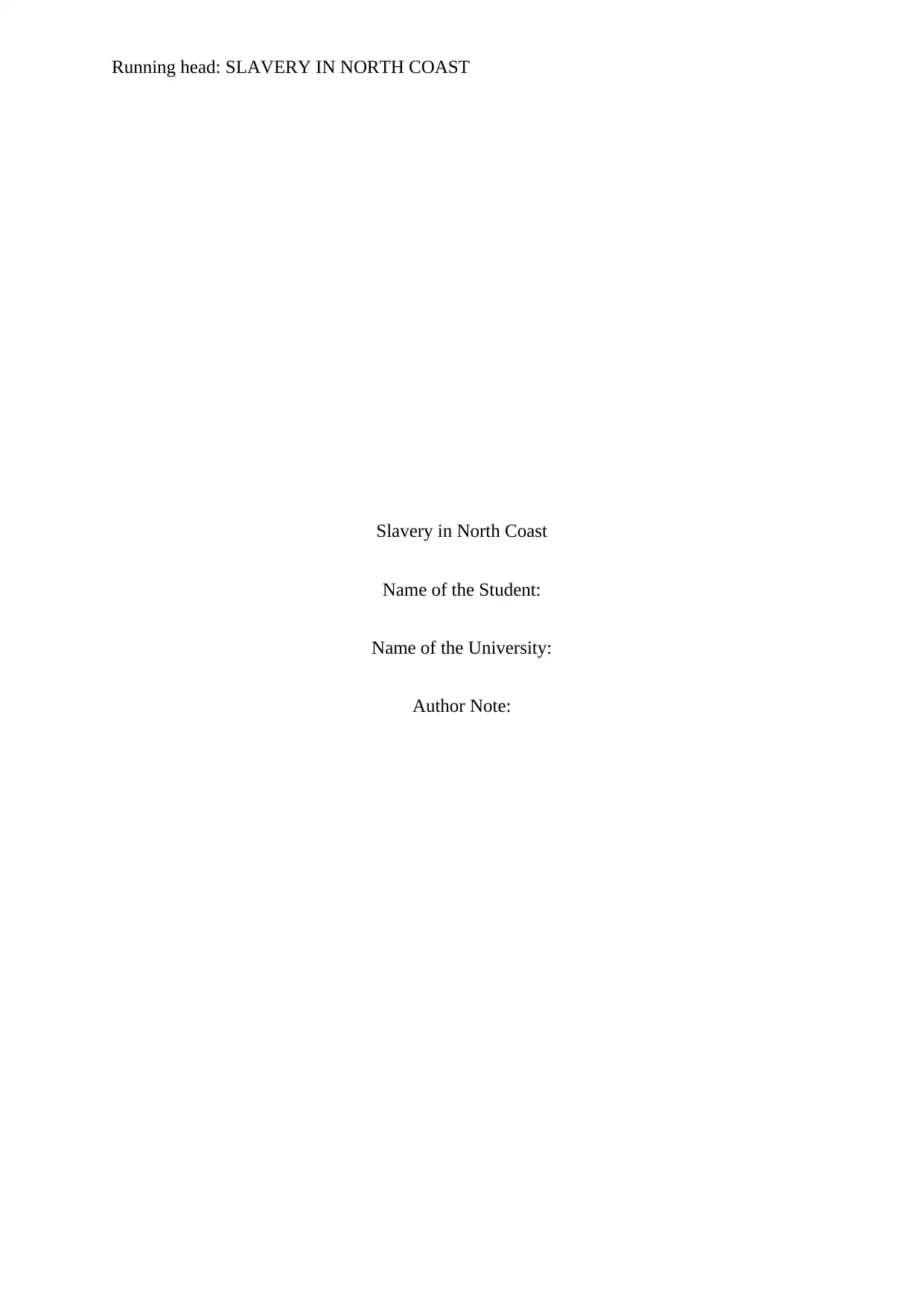
Running head: SLAVERY IN NORTH COAST
Slavery in North Coast
Name of the Student:
Name of the University:
Author Note:
Slavery in North Coast
Name of the Student:
Name of the University:
Author Note:
Paraphrase This Document
Need a fresh take? Get an instant paraphrase of this document with our AI Paraphraser
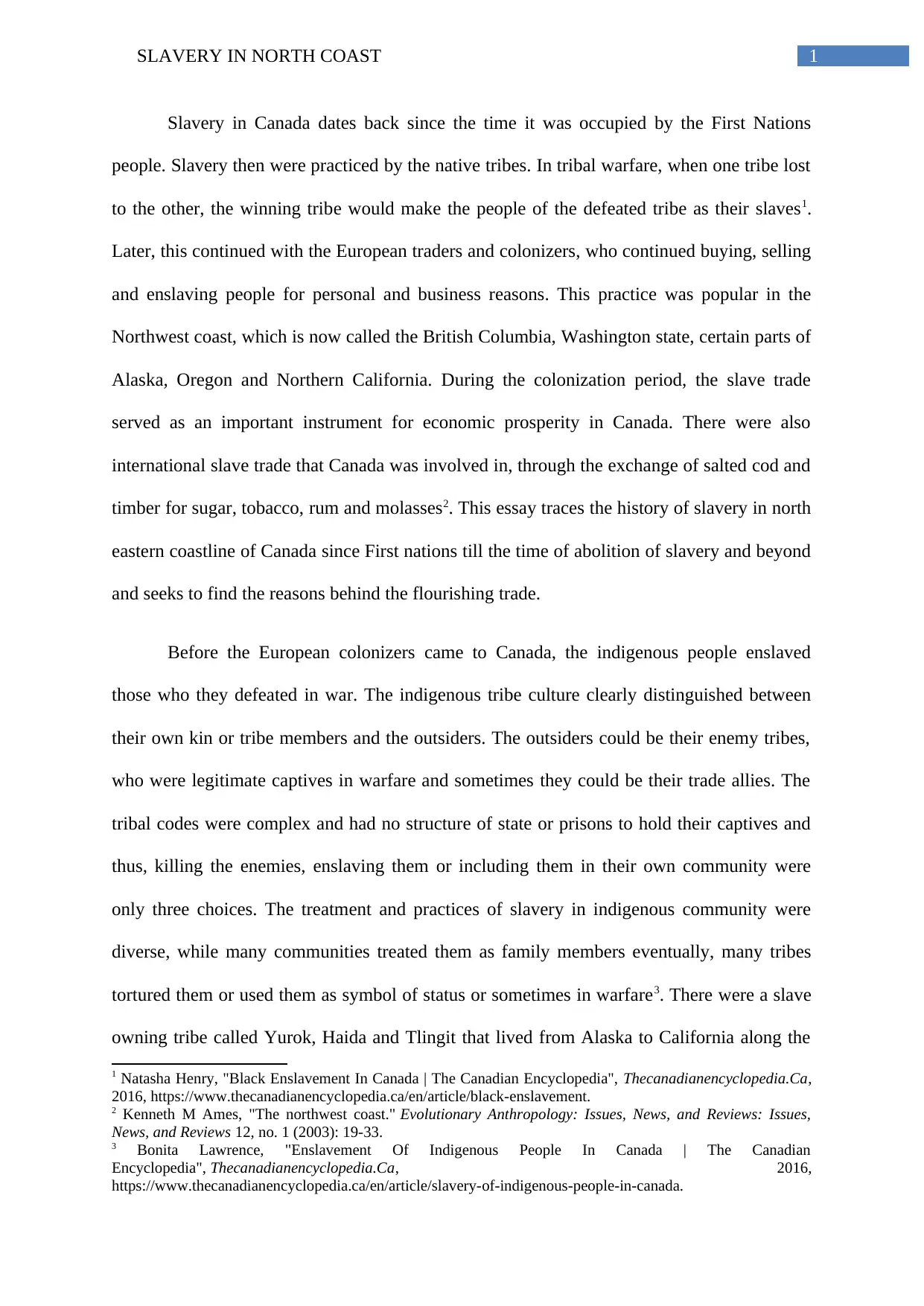
1SLAVERY IN NORTH COAST
Slavery in Canada dates back since the time it was occupied by the First Nations
people. Slavery then were practiced by the native tribes. In tribal warfare, when one tribe lost
to the other, the winning tribe would make the people of the defeated tribe as their slaves1.
Later, this continued with the European traders and colonizers, who continued buying, selling
and enslaving people for personal and business reasons. This practice was popular in the
Northwest coast, which is now called the British Columbia, Washington state, certain parts of
Alaska, Oregon and Northern California. During the colonization period, the slave trade
served as an important instrument for economic prosperity in Canada. There were also
international slave trade that Canada was involved in, through the exchange of salted cod and
timber for sugar, tobacco, rum and molasses2. This essay traces the history of slavery in north
eastern coastline of Canada since First nations till the time of abolition of slavery and beyond
and seeks to find the reasons behind the flourishing trade.
Before the European colonizers came to Canada, the indigenous people enslaved
those who they defeated in war. The indigenous tribe culture clearly distinguished between
their own kin or tribe members and the outsiders. The outsiders could be their enemy tribes,
who were legitimate captives in warfare and sometimes they could be their trade allies. The
tribal codes were complex and had no structure of state or prisons to hold their captives and
thus, killing the enemies, enslaving them or including them in their own community were
only three choices. The treatment and practices of slavery in indigenous community were
diverse, while many communities treated them as family members eventually, many tribes
tortured them or used them as symbol of status or sometimes in warfare3. There were a slave
owning tribe called Yurok, Haida and Tlingit that lived from Alaska to California along the
1 Natasha Henry, "Black Enslavement In Canada | The Canadian Encyclopedia", Thecanadianencyclopedia.Ca,
2016, https://www.thecanadianencyclopedia.ca/en/article/black-enslavement.
2 Kenneth M Ames, "The northwest coast." Evolutionary Anthropology: Issues, News, and Reviews: Issues,
News, and Reviews 12, no. 1 (2003): 19-33.
3 Bonita Lawrence, "Enslavement Of Indigenous People In Canada | The Canadian
Encyclopedia", Thecanadianencyclopedia.Ca, 2016,
https://www.thecanadianencyclopedia.ca/en/article/slavery-of-indigenous-people-in-canada.
Slavery in Canada dates back since the time it was occupied by the First Nations
people. Slavery then were practiced by the native tribes. In tribal warfare, when one tribe lost
to the other, the winning tribe would make the people of the defeated tribe as their slaves1.
Later, this continued with the European traders and colonizers, who continued buying, selling
and enslaving people for personal and business reasons. This practice was popular in the
Northwest coast, which is now called the British Columbia, Washington state, certain parts of
Alaska, Oregon and Northern California. During the colonization period, the slave trade
served as an important instrument for economic prosperity in Canada. There were also
international slave trade that Canada was involved in, through the exchange of salted cod and
timber for sugar, tobacco, rum and molasses2. This essay traces the history of slavery in north
eastern coastline of Canada since First nations till the time of abolition of slavery and beyond
and seeks to find the reasons behind the flourishing trade.
Before the European colonizers came to Canada, the indigenous people enslaved
those who they defeated in war. The indigenous tribe culture clearly distinguished between
their own kin or tribe members and the outsiders. The outsiders could be their enemy tribes,
who were legitimate captives in warfare and sometimes they could be their trade allies. The
tribal codes were complex and had no structure of state or prisons to hold their captives and
thus, killing the enemies, enslaving them or including them in their own community were
only three choices. The treatment and practices of slavery in indigenous community were
diverse, while many communities treated them as family members eventually, many tribes
tortured them or used them as symbol of status or sometimes in warfare3. There were a slave
owning tribe called Yurok, Haida and Tlingit that lived from Alaska to California along the
1 Natasha Henry, "Black Enslavement In Canada | The Canadian Encyclopedia", Thecanadianencyclopedia.Ca,
2016, https://www.thecanadianencyclopedia.ca/en/article/black-enslavement.
2 Kenneth M Ames, "The northwest coast." Evolutionary Anthropology: Issues, News, and Reviews: Issues,
News, and Reviews 12, no. 1 (2003): 19-33.
3 Bonita Lawrence, "Enslavement Of Indigenous People In Canada | The Canadian
Encyclopedia", Thecanadianencyclopedia.Ca, 2016,
https://www.thecanadianencyclopedia.ca/en/article/slavery-of-indigenous-people-in-canada.
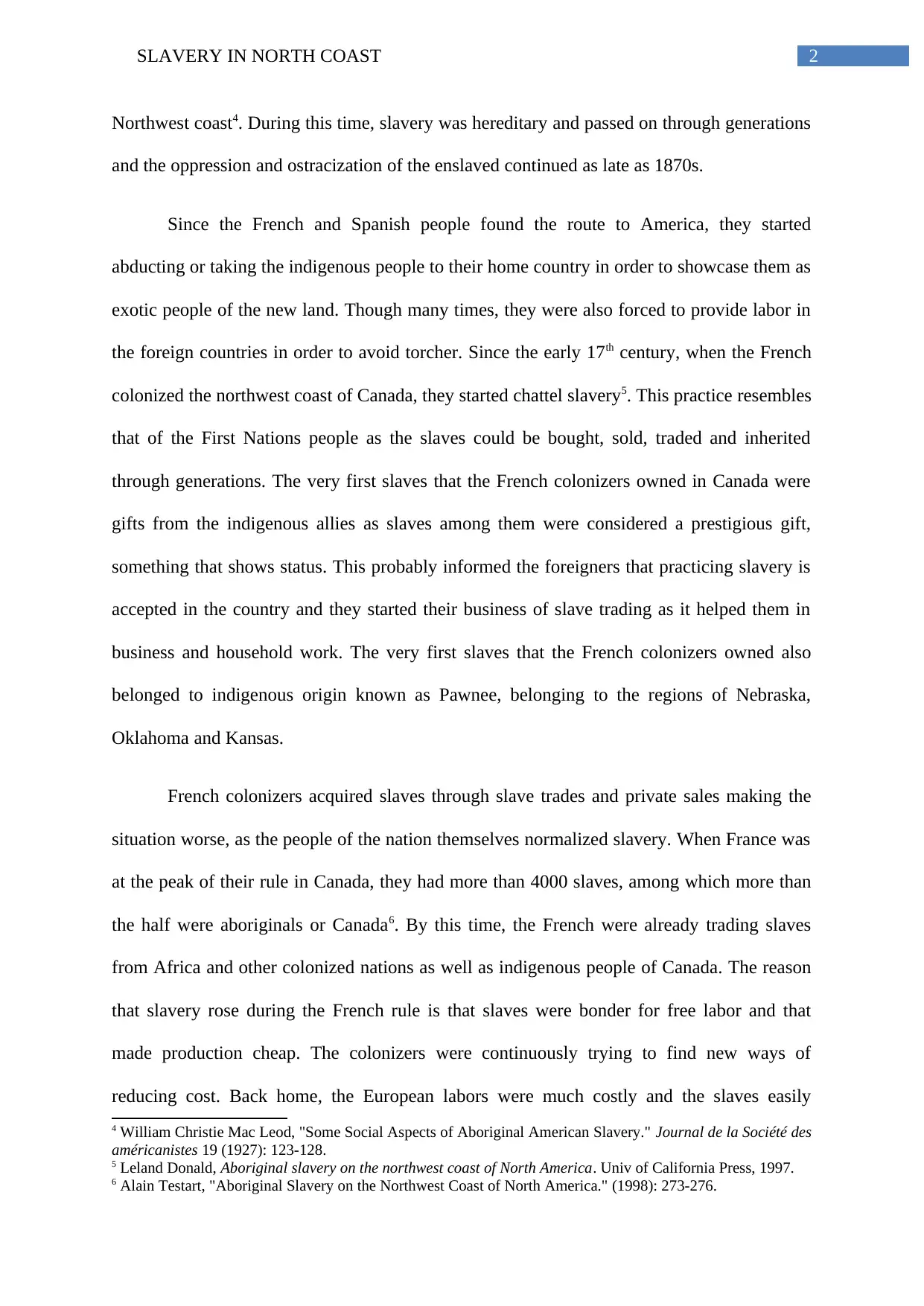
2SLAVERY IN NORTH COAST
Northwest coast4. During this time, slavery was hereditary and passed on through generations
and the oppression and ostracization of the enslaved continued as late as 1870s.
Since the French and Spanish people found the route to America, they started
abducting or taking the indigenous people to their home country in order to showcase them as
exotic people of the new land. Though many times, they were also forced to provide labor in
the foreign countries in order to avoid torcher. Since the early 17th century, when the French
colonized the northwest coast of Canada, they started chattel slavery5. This practice resembles
that of the First Nations people as the slaves could be bought, sold, traded and inherited
through generations. The very first slaves that the French colonizers owned in Canada were
gifts from the indigenous allies as slaves among them were considered a prestigious gift,
something that shows status. This probably informed the foreigners that practicing slavery is
accepted in the country and they started their business of slave trading as it helped them in
business and household work. The very first slaves that the French colonizers owned also
belonged to indigenous origin known as Pawnee, belonging to the regions of Nebraska,
Oklahoma and Kansas.
French colonizers acquired slaves through slave trades and private sales making the
situation worse, as the people of the nation themselves normalized slavery. When France was
at the peak of their rule in Canada, they had more than 4000 slaves, among which more than
the half were aboriginals or Canada6. By this time, the French were already trading slaves
from Africa and other colonized nations as well as indigenous people of Canada. The reason
that slavery rose during the French rule is that slaves were bonder for free labor and that
made production cheap. The colonizers were continuously trying to find new ways of
reducing cost. Back home, the European labors were much costly and the slaves easily
4 William Christie Mac Leod, "Some Social Aspects of Aboriginal American Slavery." Journal de la Société des
américanistes 19 (1927): 123-128.
5 Leland Donald, Aboriginal slavery on the northwest coast of North America. Univ of California Press, 1997.
6 Alain Testart, "Aboriginal Slavery on the Northwest Coast of North America." (1998): 273-276.
Northwest coast4. During this time, slavery was hereditary and passed on through generations
and the oppression and ostracization of the enslaved continued as late as 1870s.
Since the French and Spanish people found the route to America, they started
abducting or taking the indigenous people to their home country in order to showcase them as
exotic people of the new land. Though many times, they were also forced to provide labor in
the foreign countries in order to avoid torcher. Since the early 17th century, when the French
colonized the northwest coast of Canada, they started chattel slavery5. This practice resembles
that of the First Nations people as the slaves could be bought, sold, traded and inherited
through generations. The very first slaves that the French colonizers owned in Canada were
gifts from the indigenous allies as slaves among them were considered a prestigious gift,
something that shows status. This probably informed the foreigners that practicing slavery is
accepted in the country and they started their business of slave trading as it helped them in
business and household work. The very first slaves that the French colonizers owned also
belonged to indigenous origin known as Pawnee, belonging to the regions of Nebraska,
Oklahoma and Kansas.
French colonizers acquired slaves through slave trades and private sales making the
situation worse, as the people of the nation themselves normalized slavery. When France was
at the peak of their rule in Canada, they had more than 4000 slaves, among which more than
the half were aboriginals or Canada6. By this time, the French were already trading slaves
from Africa and other colonized nations as well as indigenous people of Canada. The reason
that slavery rose during the French rule is that slaves were bonder for free labor and that
made production cheap. The colonizers were continuously trying to find new ways of
reducing cost. Back home, the European labors were much costly and the slaves easily
4 William Christie Mac Leod, "Some Social Aspects of Aboriginal American Slavery." Journal de la Société des
américanistes 19 (1927): 123-128.
5 Leland Donald, Aboriginal slavery on the northwest coast of North America. Univ of California Press, 1997.
6 Alain Testart, "Aboriginal Slavery on the Northwest Coast of North America." (1998): 273-276.
⊘ This is a preview!⊘
Do you want full access?
Subscribe today to unlock all pages.

Trusted by 1+ million students worldwide
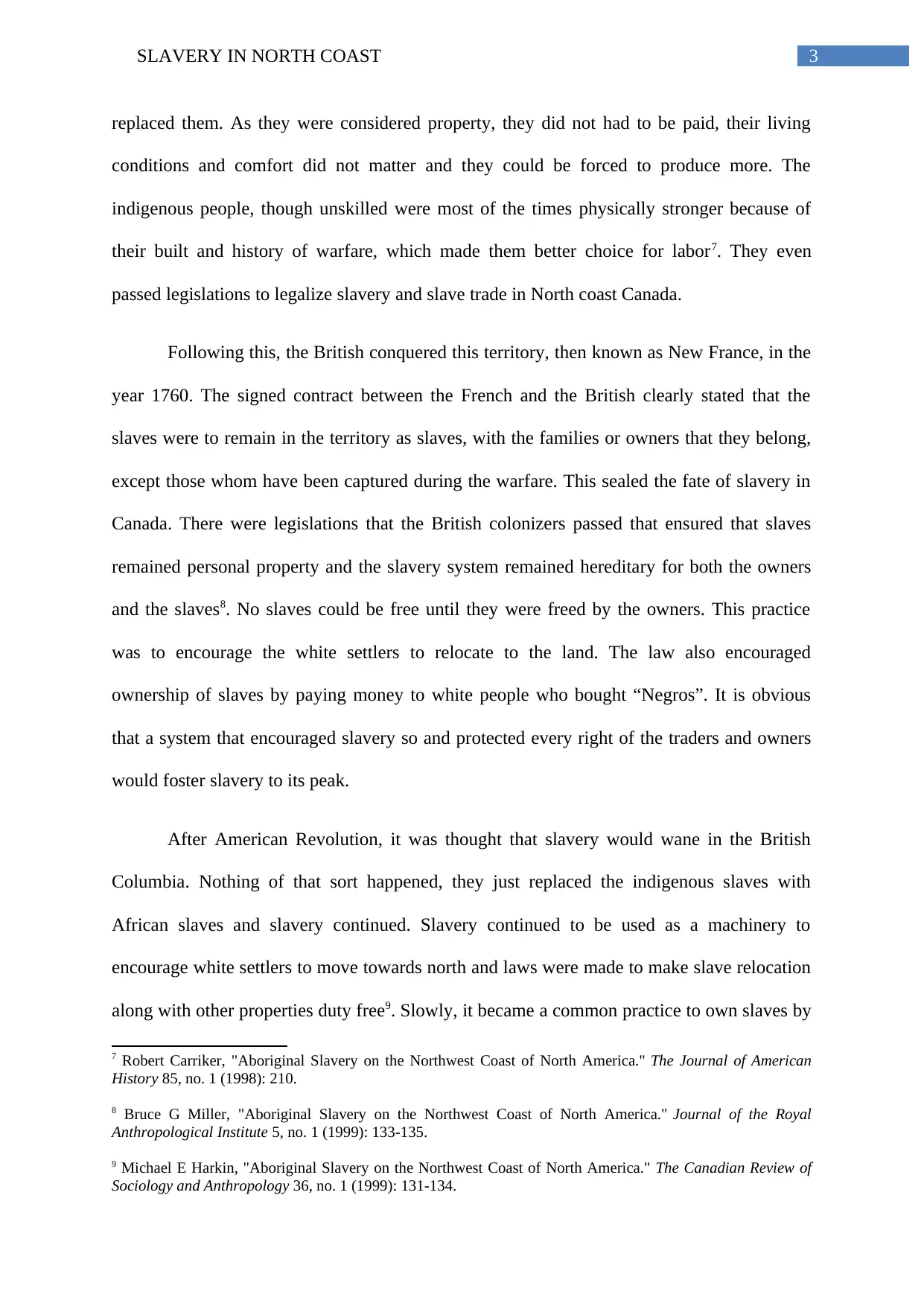
3SLAVERY IN NORTH COAST
replaced them. As they were considered property, they did not had to be paid, their living
conditions and comfort did not matter and they could be forced to produce more. The
indigenous people, though unskilled were most of the times physically stronger because of
their built and history of warfare, which made them better choice for labor7. They even
passed legislations to legalize slavery and slave trade in North coast Canada.
Following this, the British conquered this territory, then known as New France, in the
year 1760. The signed contract between the French and the British clearly stated that the
slaves were to remain in the territory as slaves, with the families or owners that they belong,
except those whom have been captured during the warfare. This sealed the fate of slavery in
Canada. There were legislations that the British colonizers passed that ensured that slaves
remained personal property and the slavery system remained hereditary for both the owners
and the slaves8. No slaves could be free until they were freed by the owners. This practice
was to encourage the white settlers to relocate to the land. The law also encouraged
ownership of slaves by paying money to white people who bought “Negros”. It is obvious
that a system that encouraged slavery so and protected every right of the traders and owners
would foster slavery to its peak.
After American Revolution, it was thought that slavery would wane in the British
Columbia. Nothing of that sort happened, they just replaced the indigenous slaves with
African slaves and slavery continued. Slavery continued to be used as a machinery to
encourage white settlers to move towards north and laws were made to make slave relocation
along with other properties duty free9. Slowly, it became a common practice to own slaves by
7 Robert Carriker, "Aboriginal Slavery on the Northwest Coast of North America." The Journal of American
History 85, no. 1 (1998): 210.
8 Bruce G Miller, "Aboriginal Slavery on the Northwest Coast of North America." Journal of the Royal
Anthropological Institute 5, no. 1 (1999): 133-135.
9 Michael E Harkin, "Aboriginal Slavery on the Northwest Coast of North America." The Canadian Review of
Sociology and Anthropology 36, no. 1 (1999): 131-134.
replaced them. As they were considered property, they did not had to be paid, their living
conditions and comfort did not matter and they could be forced to produce more. The
indigenous people, though unskilled were most of the times physically stronger because of
their built and history of warfare, which made them better choice for labor7. They even
passed legislations to legalize slavery and slave trade in North coast Canada.
Following this, the British conquered this territory, then known as New France, in the
year 1760. The signed contract between the French and the British clearly stated that the
slaves were to remain in the territory as slaves, with the families or owners that they belong,
except those whom have been captured during the warfare. This sealed the fate of slavery in
Canada. There were legislations that the British colonizers passed that ensured that slaves
remained personal property and the slavery system remained hereditary for both the owners
and the slaves8. No slaves could be free until they were freed by the owners. This practice
was to encourage the white settlers to relocate to the land. The law also encouraged
ownership of slaves by paying money to white people who bought “Negros”. It is obvious
that a system that encouraged slavery so and protected every right of the traders and owners
would foster slavery to its peak.
After American Revolution, it was thought that slavery would wane in the British
Columbia. Nothing of that sort happened, they just replaced the indigenous slaves with
African slaves and slavery continued. Slavery continued to be used as a machinery to
encourage white settlers to move towards north and laws were made to make slave relocation
along with other properties duty free9. Slowly, it became a common practice to own slaves by
7 Robert Carriker, "Aboriginal Slavery on the Northwest Coast of North America." The Journal of American
History 85, no. 1 (1998): 210.
8 Bruce G Miller, "Aboriginal Slavery on the Northwest Coast of North America." Journal of the Royal
Anthropological Institute 5, no. 1 (1999): 133-135.
9 Michael E Harkin, "Aboriginal Slavery on the Northwest Coast of North America." The Canadian Review of
Sociology and Anthropology 36, no. 1 (1999): 131-134.
Paraphrase This Document
Need a fresh take? Get an instant paraphrase of this document with our AI Paraphraser
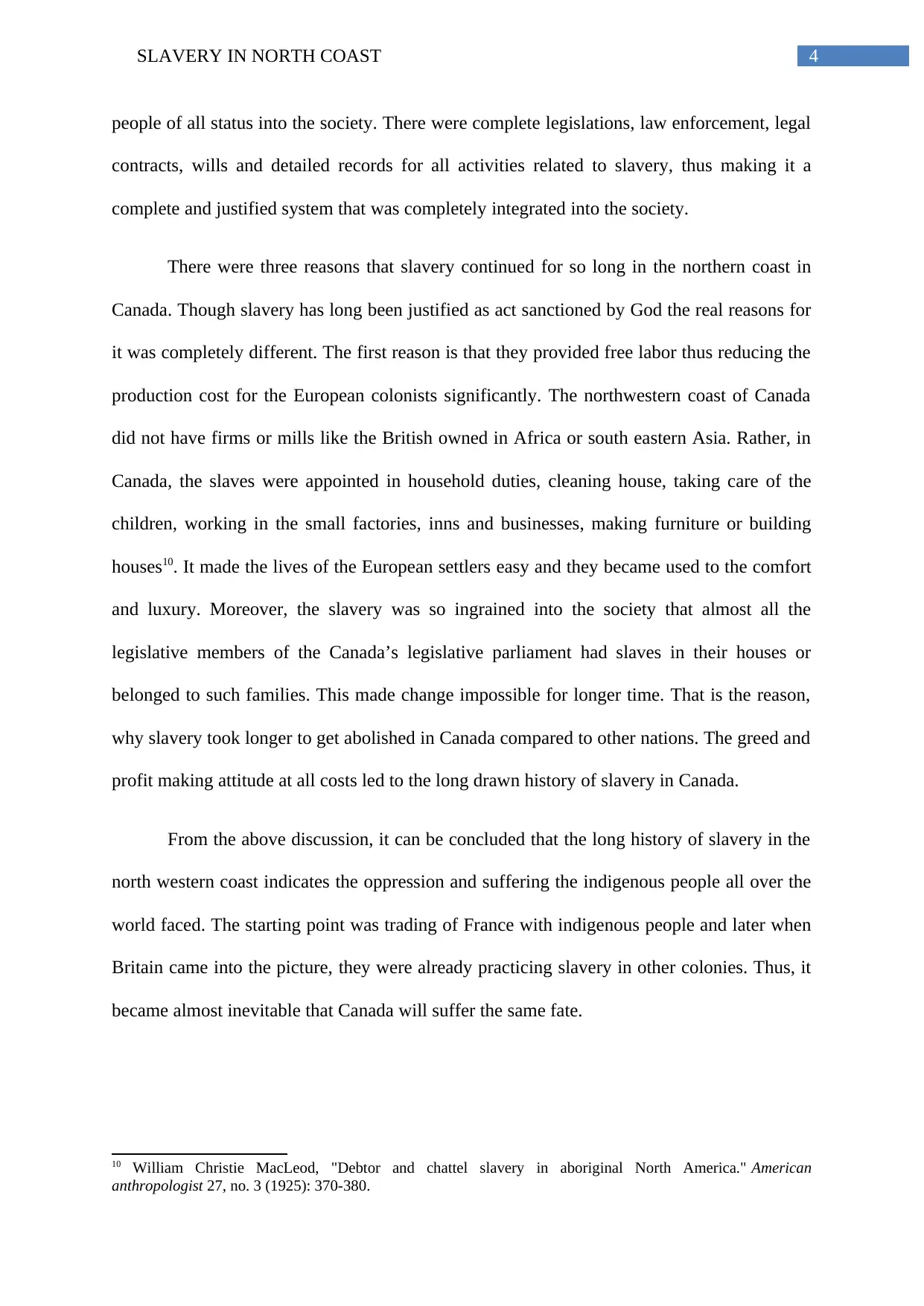
4SLAVERY IN NORTH COAST
people of all status into the society. There were complete legislations, law enforcement, legal
contracts, wills and detailed records for all activities related to slavery, thus making it a
complete and justified system that was completely integrated into the society.
There were three reasons that slavery continued for so long in the northern coast in
Canada. Though slavery has long been justified as act sanctioned by God the real reasons for
it was completely different. The first reason is that they provided free labor thus reducing the
production cost for the European colonists significantly. The northwestern coast of Canada
did not have firms or mills like the British owned in Africa or south eastern Asia. Rather, in
Canada, the slaves were appointed in household duties, cleaning house, taking care of the
children, working in the small factories, inns and businesses, making furniture or building
houses10. It made the lives of the European settlers easy and they became used to the comfort
and luxury. Moreover, the slavery was so ingrained into the society that almost all the
legislative members of the Canada’s legislative parliament had slaves in their houses or
belonged to such families. This made change impossible for longer time. That is the reason,
why slavery took longer to get abolished in Canada compared to other nations. The greed and
profit making attitude at all costs led to the long drawn history of slavery in Canada.
From the above discussion, it can be concluded that the long history of slavery in the
north western coast indicates the oppression and suffering the indigenous people all over the
world faced. The starting point was trading of France with indigenous people and later when
Britain came into the picture, they were already practicing slavery in other colonies. Thus, it
became almost inevitable that Canada will suffer the same fate.
10 William Christie MacLeod, "Debtor and chattel slavery in aboriginal North America." American
anthropologist 27, no. 3 (1925): 370-380.
people of all status into the society. There were complete legislations, law enforcement, legal
contracts, wills and detailed records for all activities related to slavery, thus making it a
complete and justified system that was completely integrated into the society.
There were three reasons that slavery continued for so long in the northern coast in
Canada. Though slavery has long been justified as act sanctioned by God the real reasons for
it was completely different. The first reason is that they provided free labor thus reducing the
production cost for the European colonists significantly. The northwestern coast of Canada
did not have firms or mills like the British owned in Africa or south eastern Asia. Rather, in
Canada, the slaves were appointed in household duties, cleaning house, taking care of the
children, working in the small factories, inns and businesses, making furniture or building
houses10. It made the lives of the European settlers easy and they became used to the comfort
and luxury. Moreover, the slavery was so ingrained into the society that almost all the
legislative members of the Canada’s legislative parliament had slaves in their houses or
belonged to such families. This made change impossible for longer time. That is the reason,
why slavery took longer to get abolished in Canada compared to other nations. The greed and
profit making attitude at all costs led to the long drawn history of slavery in Canada.
From the above discussion, it can be concluded that the long history of slavery in the
north western coast indicates the oppression and suffering the indigenous people all over the
world faced. The starting point was trading of France with indigenous people and later when
Britain came into the picture, they were already practicing slavery in other colonies. Thus, it
became almost inevitable that Canada will suffer the same fate.
10 William Christie MacLeod, "Debtor and chattel slavery in aboriginal North America." American
anthropologist 27, no. 3 (1925): 370-380.
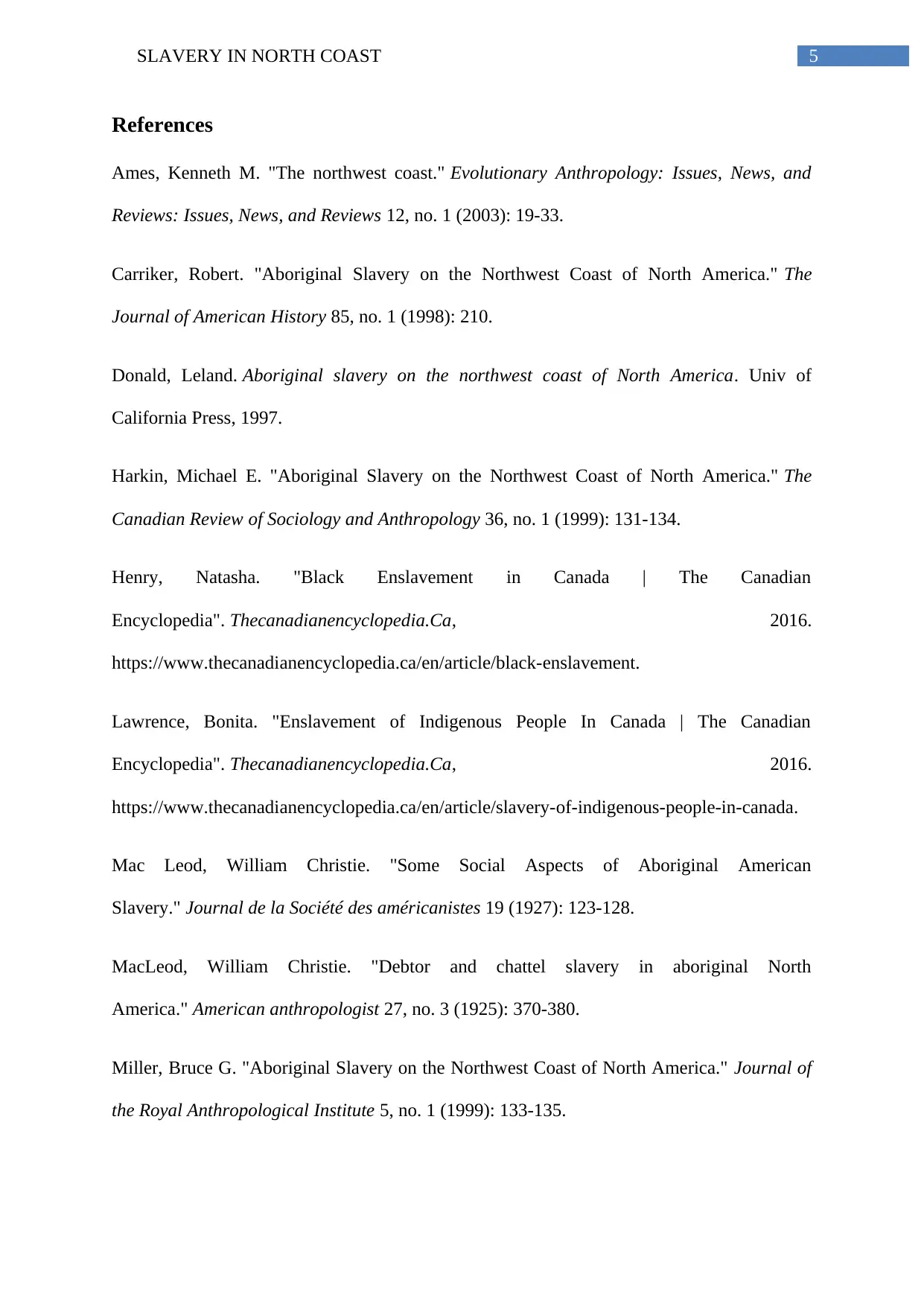
5SLAVERY IN NORTH COAST
References
Ames, Kenneth M. "The northwest coast." Evolutionary Anthropology: Issues, News, and
Reviews: Issues, News, and Reviews 12, no. 1 (2003): 19-33.
Carriker, Robert. "Aboriginal Slavery on the Northwest Coast of North America." The
Journal of American History 85, no. 1 (1998): 210.
Donald, Leland. Aboriginal slavery on the northwest coast of North America. Univ of
California Press, 1997.
Harkin, Michael E. "Aboriginal Slavery on the Northwest Coast of North America." The
Canadian Review of Sociology and Anthropology 36, no. 1 (1999): 131-134.
Henry, Natasha. "Black Enslavement in Canada | The Canadian
Encyclopedia". Thecanadianencyclopedia.Ca, 2016.
https://www.thecanadianencyclopedia.ca/en/article/black-enslavement.
Lawrence, Bonita. "Enslavement of Indigenous People In Canada | The Canadian
Encyclopedia". Thecanadianencyclopedia.Ca, 2016.
https://www.thecanadianencyclopedia.ca/en/article/slavery-of-indigenous-people-in-canada.
Mac Leod, William Christie. "Some Social Aspects of Aboriginal American
Slavery." Journal de la Société des américanistes 19 (1927): 123-128.
MacLeod, William Christie. "Debtor and chattel slavery in aboriginal North
America." American anthropologist 27, no. 3 (1925): 370-380.
Miller, Bruce G. "Aboriginal Slavery on the Northwest Coast of North America." Journal of
the Royal Anthropological Institute 5, no. 1 (1999): 133-135.
References
Ames, Kenneth M. "The northwest coast." Evolutionary Anthropology: Issues, News, and
Reviews: Issues, News, and Reviews 12, no. 1 (2003): 19-33.
Carriker, Robert. "Aboriginal Slavery on the Northwest Coast of North America." The
Journal of American History 85, no. 1 (1998): 210.
Donald, Leland. Aboriginal slavery on the northwest coast of North America. Univ of
California Press, 1997.
Harkin, Michael E. "Aboriginal Slavery on the Northwest Coast of North America." The
Canadian Review of Sociology and Anthropology 36, no. 1 (1999): 131-134.
Henry, Natasha. "Black Enslavement in Canada | The Canadian
Encyclopedia". Thecanadianencyclopedia.Ca, 2016.
https://www.thecanadianencyclopedia.ca/en/article/black-enslavement.
Lawrence, Bonita. "Enslavement of Indigenous People In Canada | The Canadian
Encyclopedia". Thecanadianencyclopedia.Ca, 2016.
https://www.thecanadianencyclopedia.ca/en/article/slavery-of-indigenous-people-in-canada.
Mac Leod, William Christie. "Some Social Aspects of Aboriginal American
Slavery." Journal de la Société des américanistes 19 (1927): 123-128.
MacLeod, William Christie. "Debtor and chattel slavery in aboriginal North
America." American anthropologist 27, no. 3 (1925): 370-380.
Miller, Bruce G. "Aboriginal Slavery on the Northwest Coast of North America." Journal of
the Royal Anthropological Institute 5, no. 1 (1999): 133-135.
⊘ This is a preview!⊘
Do you want full access?
Subscribe today to unlock all pages.

Trusted by 1+ million students worldwide
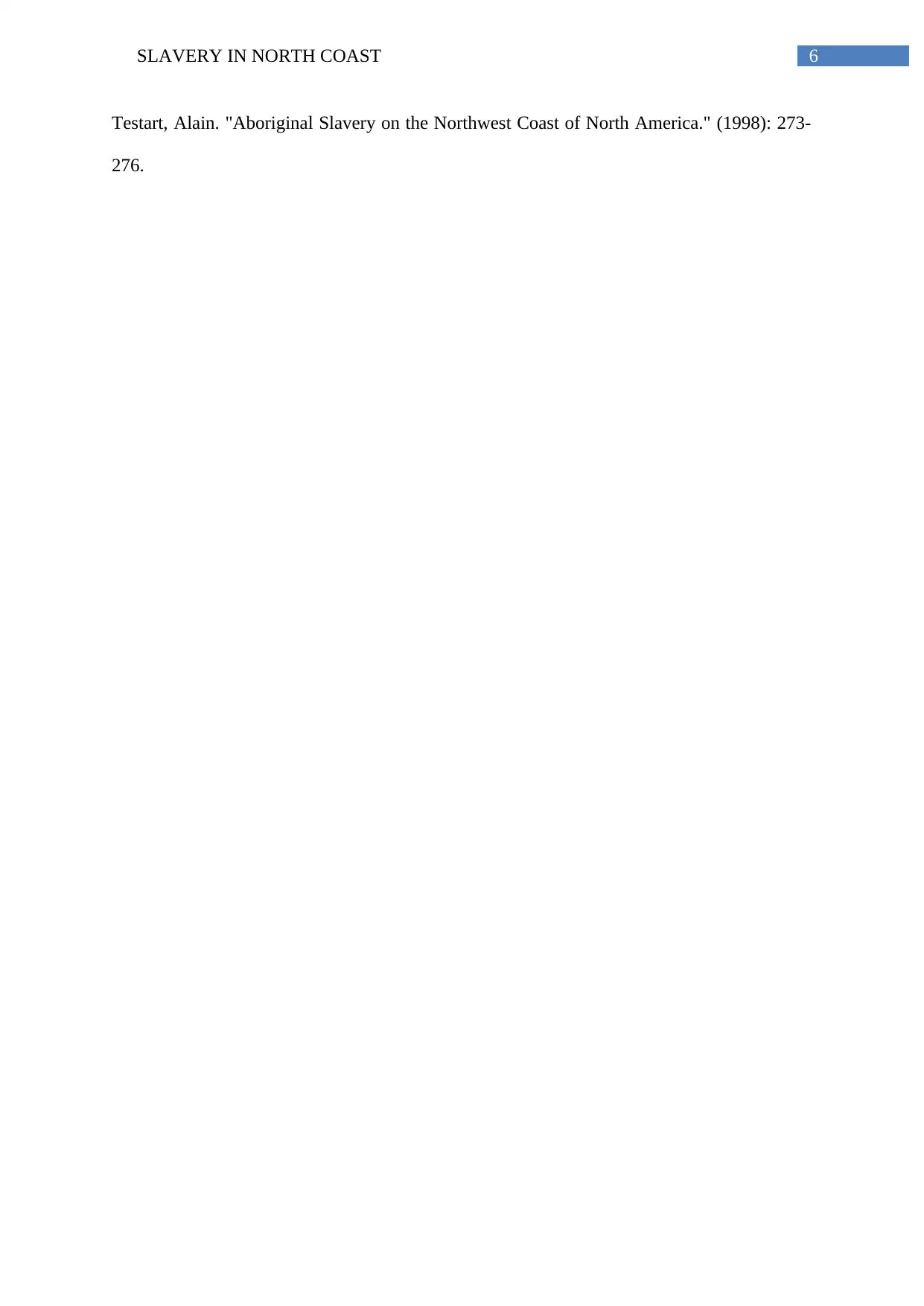
6SLAVERY IN NORTH COAST
Testart, Alain. "Aboriginal Slavery on the Northwest Coast of North America." (1998): 273-
276.
Testart, Alain. "Aboriginal Slavery on the Northwest Coast of North America." (1998): 273-
276.
1 out of 7
Your All-in-One AI-Powered Toolkit for Academic Success.
+13062052269
info@desklib.com
Available 24*7 on WhatsApp / Email
![[object Object]](/_next/static/media/star-bottom.7253800d.svg)
Unlock your academic potential
Copyright © 2020–2025 A2Z Services. All Rights Reserved. Developed and managed by ZUCOL.
